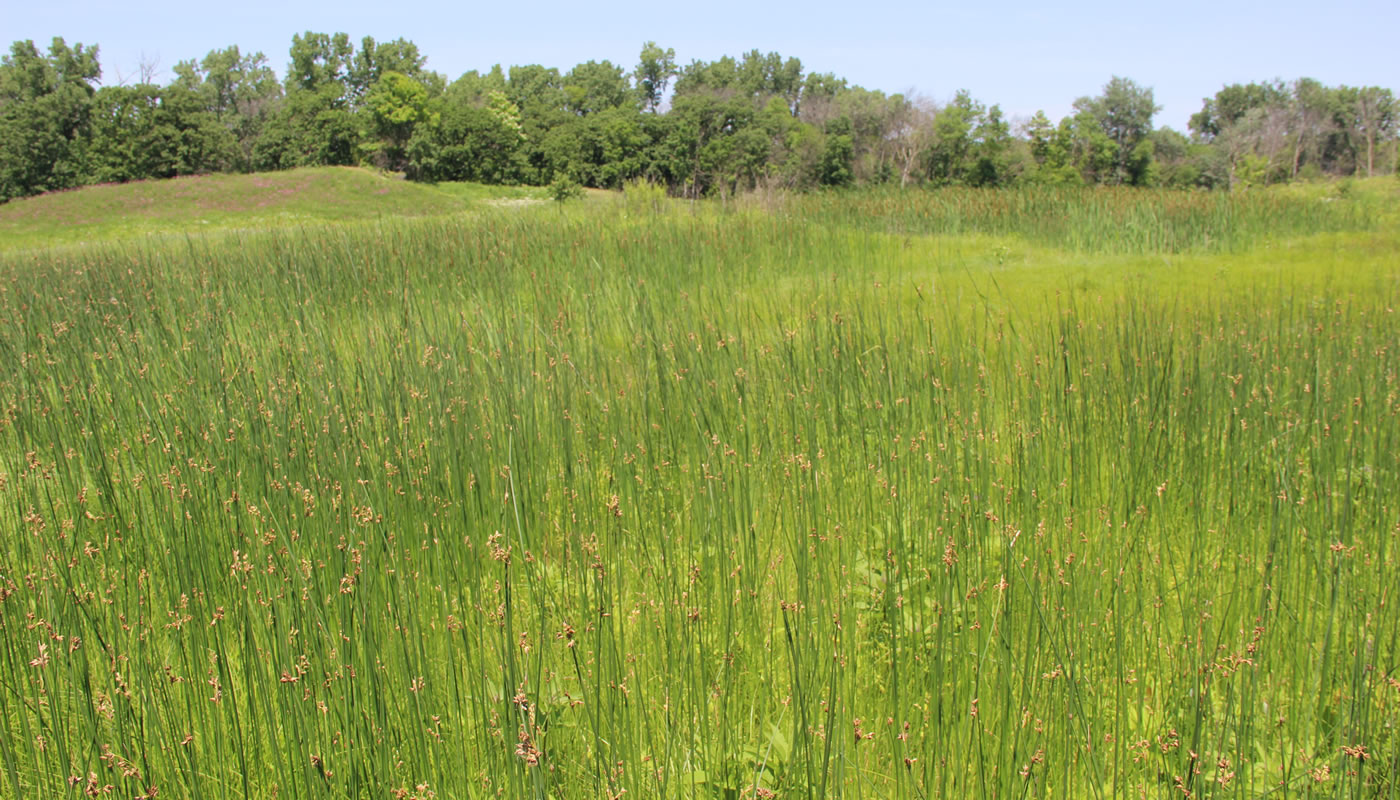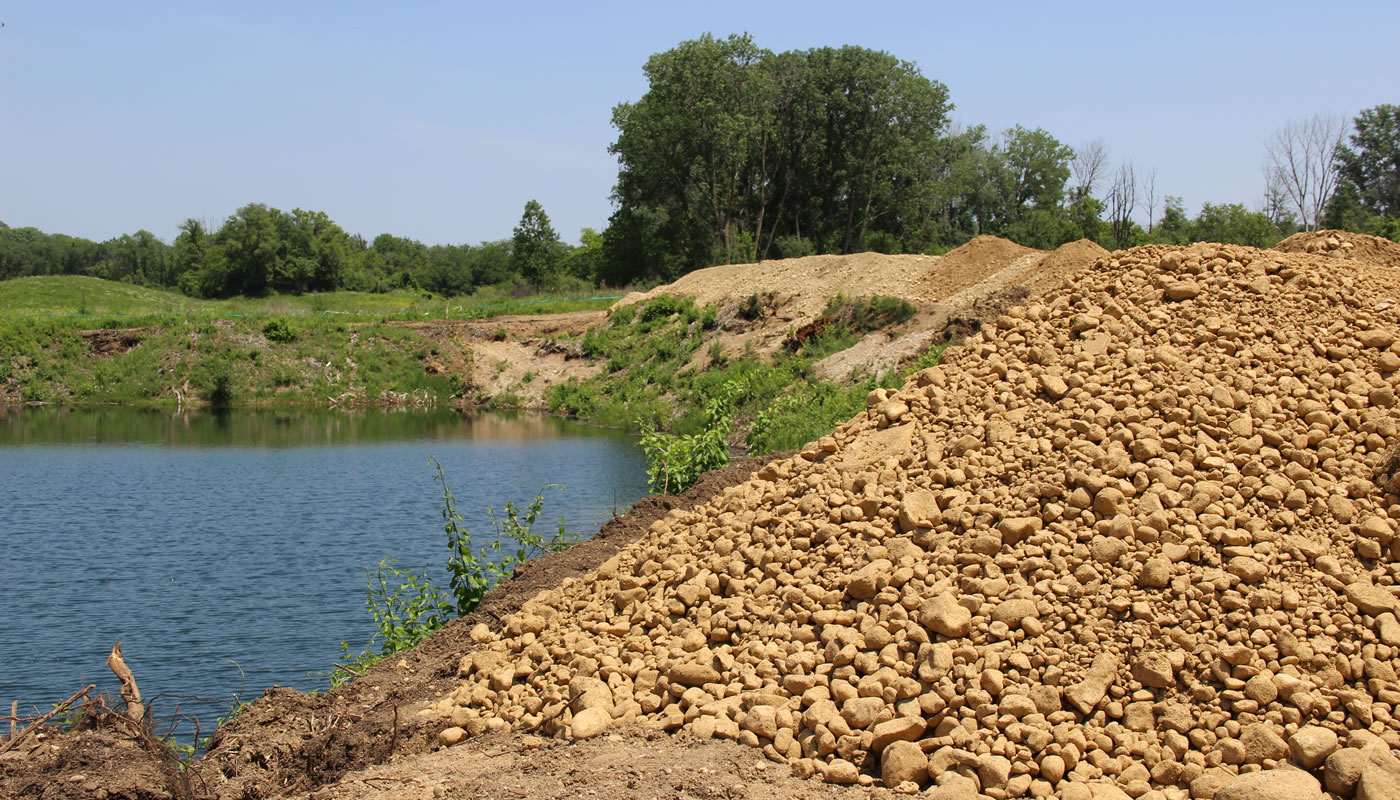How resculpting the landscape is expanding one of our rarest ecosystems.
Bluff Spring Fen in Elgin has had more than its fair share of ups and downs. Gravel and sand mining and other industrial operations have long surrounded the site. Parts of the fen—a rare type of wetland that must be supplied with cool water from underground springs—were mined beginning in the 1930s. People illegally dumped abandoned vehicles and landscape debris. The site was rutted by countless off-road vehicles and inundated by invasive species.
But decades ago, the tide turned. In 1980, Bluff Spring Fen was adopted by volunteers, who hauled away the junk, dramatically cleared the invasives and helped bring back the native flora and fauna. In 1990, the site was the recipient of a first-of-its-kind transplant: an entire remnant hill prairie that would otherwise have been destroyed.
The latest development at Bluff Spring Fen is right in line with its dramatic past. Over the last few months, visitors may have seen trees being removed, large pipes being installed and trucks and bulldozers moving enormous piles of gravel at the far southern edge of the preserve. The project, more than a decade in the planning, is working to recontour the land, fill in pits from past excavation and create a piping system that bypasses surface-water runoff around the fen.
A key part of the Fen Protection Plan, the project is a collaborative effort between the Forest Preserves of Cook County, the Illinois Nature Preserves Commission, Friends of the Fen, Illinois State Geological Survey, Illinois State Water Survey, Vulcan Materials Corporation and Bluff City Materials, Inc.
The project’s ultimate aim is to protect the groundwater here. But why?
A place of rare beauty and unusual function
The 91-acre Bluff Spring Fen Nature Preserve is a very special place. It is one of only about a dozen fens left in Illinois. Its 25 acres of graminoid (“grassy”) fen represent just under 20 percent of the 133 acres of high-quality graminoid fen that survive in Illinois. Calcareous seep fens, where groundwater visibly bubbles to the surface, are even rarer than that. Only 14.5 acres survive in Illinois, about a half-acre of it at Bluff Spring Fen.
The fens inhabit the lowest areas of the Bluff Spring Fen preserve and support an incredible array of plants. Rare plants such as Ohio goldenrod, flat-topped aster, cotton grass and fen star sedge send all manner of brilliant flowers and geometrically complex seedheads out of the dampness. Rare butterflies such as the Baltimore checkerspot thrive here. The fens lie amidst gravel hills that support oak savannas and hill prairies. Here, a different suite of conservative plants and animals thrive, including giant bur oaks, side-oats gramma grass and meadow jumping mouse.

The fen habitats at Bluff Spring Fen completely depend on an uninterrupted and unaltered flow of groundwater. If that flow is altered, the unique fen plant communities will be lost. Rainwater falls on high areas around the fen and enters the ground. It then flows diagonally through layers of sand, gravel and stone. Along the way, the water picks up minerals such as calcium carbonate that radically alter its chemistry. When it emerges from the earth as a bubbling spring in the fen below, the water is so alkaline, or basic, that only certain rare plant species can withstand the conditions. These well-adapted plants, including valerian, beaked spike rush and Kalm’s lobelia, have a competitive advantage here, since other plants find this unique environment toxic.
What the bulldozers are doing
Early work prepared the ground for installation of a buried drainage pipe that extends from Route 20 to Poplar Creek, a route where water travels over the surface during extreme rainfall events. The nearly one-third-mile long piping system that Vulcan and Bluff City Materials are installing will help to ensure long-term survival of the fen. It seeks to address surface water issues that affect many preserves but especially impact a sensitive fen. “There’s almost a square mile of watershed upstream of the fen,” says Steve Kaminski of Mackie Consultants. “Because of so much hardening of the landscape, the watershed is much peakier [more extreme periods of high water and low water] than it used to be. We needed a comprehensive water management plan.” The pipeline is designed to keep the pure, cool groundwater separate from the surface water flowing out of Gifford Lake and running off of industrial areas located south of the fen.

The project is also recontouring old gravel mining spoils piled on top of former fen. The contouring will enable the Forest Preserves and the Friends of the Fen to restore land that had been badly degraded by earlier mining operations and subsequently invaded by woody, invasive trees.
Bluff City Materials is helping to further restore the groundwater resource near an old gravel pit by filling it with sand and gravel from a nearby source. Fortunately, a neighboring company needed to excavate the same type of sand and gravel that was removed more than 75 years ago from the pit at Bluff Spring Fen. The pit being restored and others that extend east toward Gifford Road are the result of gravel mining dating back to the 1930s.
“By removing the gravel, the rainwater was not filtering through the sand and gravel as it once did,” says Jim Miner, wetlands geologist with the Illinois State Geological Survey. Once the gravel pits filled with water, the water was exposed to the sun and its temperature and chemical composition changed. “It’s like when you leave a soda bottle open—it warms up and slowly loses its carbonation,” says Miner. By filling in the gravel quarry pits, underground flow paths that the fen wetland needs are slowly being restored.
“You can’t just put a fen anywhere, nor do they occur anywhere,” says Steven Byers of the Illinois Nature Preserves Commission. “Their locations are fixed by ancient, underground flow paths laid down by the most recent advance (and then retreat) of glaciers into and from Illinois. And these flow paths have nourished the fen plants and animals for thousands of years. It’s little wonder now that we have so little fen left.”
Future recovery—and vigilance
The project has already made a significant step toward restoring about an acre of fen at this site, simply by recontouring degraded areas to expose the original soil. “Wetlands often have a resilient seedbank,” says Forest Preserves ecologist Deborah Antlitz. “Bring the water or sun back, and the plants often come back.”
“The collaboration shows how industry can contribute to conservation and restoration,” says Bluff City Materials’ Matt Vondra. “We really appreciate this public-private partnership and working with the agencies–they’ve done so much great work on this.” Along with Vulcan, Bluff City’s financial support for this project is one demonstration of that commitment. But an earlier agreement to extract dolomite using underground mining instead of surface mining was also instrumental in protecting the groundwater. An open pit located just south of Bluff Spring Fen would have altered groundwater flow paths. “So we’ve adopted a mining operation located 300 to 750 feet below the ground,” says Vondra. “Because it’s beneath a layer of clay, this has much less hydrological impact on the groundwater that the fen depends on.”
Bluff City Materials has also contributed financially to a long-running groundwater study conducted by Illinois State Geological Survey, resulting in an extensive model that will help resource professionals predict the impact, if any, of land use changes. Geologists and ecologists will be carefully monitoring the results, since these projects could serve as templates for restoring or improving fens at other locations in the Fox River Valley.
While the earth moving may look destructive, it represents a rare opportunity to restore and improve the groundwater on which this entire ecosystem is dependent. “We never thought we’d have an opportunity to protect this groundwater,” says Byers.
Want to learn more about Bluff Spring Fen or help out in its continued restoration? Friends of the Fen is always looking for volunteers and giving tours. Visit fpdcc.com/volunteer to find upcoming workdays.

